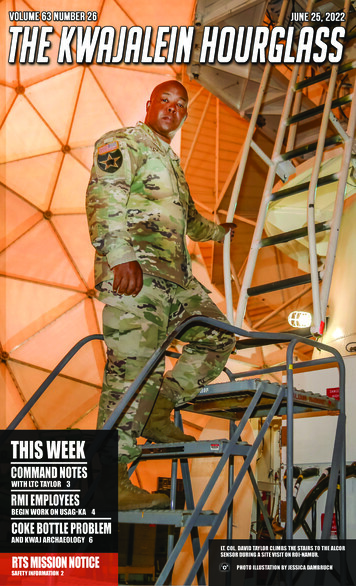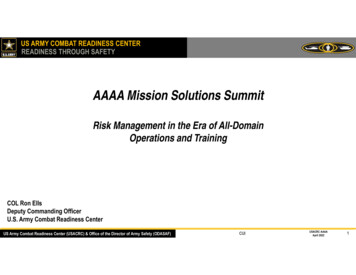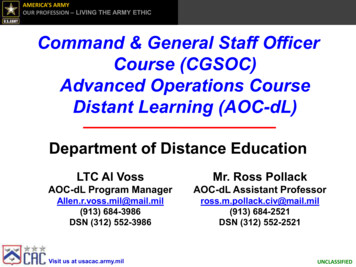
Transcription
THIS WEEKCOMMAND NOTESWITH LTC TAYLOR 3RMI EMPLOYEESBEGIN WORK ON USAG-KA 4COKE BOTTLE PROBLEMAND KWAJ ARCHAEOLOGY 6RTS MISSION NOTICESaturday,June 25,22022 / Volume 63 Number 26SAFETYINFORMATIONLT. COL. DAVID TAYLOR CLIMBS THE STAIRS TO THE ALCORSENSOR DURING A SITE VISIT ON ROI-NAMUR.1PHOTO ILLUSTATION BY JESSICA DAMBRUCHThe Kwajalein Hourglass
RONALD REAGAN BALLISTIC MISSILE DEFENSE TEST SITEMISSION ANNOUNCEMENTA RANGE OPERATION IS SCHEDULEDFOR JULY 7-8. CAUTION TIMES AREJULY 7 AT 6 P.M. THROUGH 12:58 A.M.ON JULY 8. THE BACKUP DAY OF JULY8-9 HAS THE SAME CAUTION TIMES.DURING THIS TIME, A CAUTION AREAWILL EXTEND INTO THE OPEN OCEANEAST OF THE MID-ATOLL CORRIDOR.THE MID-ATOLL CORRIDOR WILLBE CLOSED FROM 4:01 P.M. JULY 3THROUGH MISSION COMPLETION.THE CAUTION AREA EXTENDS FROMTHE SURFACE TO UNLIMITED ALTITUDE.SEE THE KWAJALEIN HOURGLASS ORROLLER DATED JUNE 25 FOR A MAPOF THE CLOSED AREAS. QUESTIONSSHOULD BE DIRECTED TO REAGANTEST SITE MISSION SAFETY OFFICE AT(805) 355-5625.JUON IEN KOKEMELMEL ENAJ KOMANILO RAN IN THURSDAY, 07 RAN LOKNAN 08 RAN IN JULY 2022. AWA KOREKAUWOTOTA EJ JEN 6 P.M. AWAJOTA LOK NAN 12:58 A.M. IN JIMAROK.RAN IN BACKUP EJ 08 LOK NAN 09RAN IN JULY 2022, IM AWA KO REKAUWOTATA EJ JEN 6 P.M. JOTA NAN 12:58A.M. IN JIMAROK.MALO IM ENE KO ILO IOLAP IN AELONIN (MID-ATOLL CORRIDOR) RENAJKILOK JEN 4:01PM AWA ELKIN RAELEPILO 03 RAN IN JULY 2022 NAN NE EDEDELOK KOKEMELMEL KEIN.LALE HOURGLASS AK ROLLER EO AN25 RAN IN JUNE IM 02 RAN IN NANAM LALE IA KO REJ KILOK. NE EWORAM KAJITOK JOUJ IM CALL E LOKKWAJALEIN RANGE SAFETY OPIJA ROILO (805) 355-5625 MISSION SUPPORTILO (805) 355-4420.MID-ATOLL CORRIDOR CLOSEDFROM JULY 3 AT 4:01 P.M. THROUGHMISSION COMPLETION.THE KWAJALEIN HOURGLASSThe Kwajalein Hourglass is named for the insignia ofthe U.S. Army's 7th Infantry Division, which liberatedthe island from the forces of Imperial Japan on Feb.4, 1944. The Kwajalein Hourglass is an authorizedpublication for military personnel, federal employees,contractor workers and their families assigned to U.S.Army Garrison-Kwajalein Atoll.Contents of the Hourglass are not necessarily officialviews of, or endorsed by, the U.S. Government, Department of Defense, Department of the Army or USAG-KA. It is published Saturdays in accordance withArmy Regulation 360-1.Phone: Defense Switching Network 254-5169Local phone: 5-5169Saturday, June 25, 2022 / Volume 63 Number 262Garrison Commander.Col. Thomas PugsleyGarrison CSM.Command Sgt. Maj. Ismael OrtegaPublic Affairs Officer.Mike BrantleyEditor.Jessica “JD” DambruchThe Kwajalein Hourglass
RANGE DIRECTOR LED REAGAN TEST SITE DURING PANDEMICLt. Col. David Taylor, Ronald Reagan Ballistic Missile Test Site range director, recently PCS’d with his wife, Elizabeth, anddaughter, Lily, after completing his tourof duty on U.S. Army Garrison-KwajaleinAtoll.Taylor, a former air defense officer, saidhe enjoyed getting to know the diverseworkforce at RTS in his unique new home.During his command, Taylor’s teamprovided uninterrupted mission support—often going above and beyond tomeet the challenges of the operationaltempo during the pandemic.The increasingly isolated conditions onKwajalein during the pandemic became aproving ground for the talents of his newsupport team, Taylor said.“For my team, as well as both the RTSteam, here and back in the states, we’vedone a good job cross-training peopleacross various disciplines to keep the mission going,” he said. “In each mission, wehave several people that come in TDY tosupport those missions. With COVID restrictions, that just wasn’t possible.”Taylor credited the Garrison and itscontract support partners for keeping theisland “open for business” through quarantine management. He thanked the numerous range employees who took on additional support roles during operationswindows.“We’ve had a lot of team memberson the island stand up, cover down andcross-train on highly technical jobs thatweren’t in their position description—from engineers becoming flight tested or[performing] work on the USAV Worthy. We’ve been able to show value in allthose things and keep the mission going,as well.”Cross-training allowed Range Generation Next employees to utilize their talents, skills and abilities to support mission roles, sometimes serving in multipledepartments at a given time.One such testament to continued forward momentum despite the pandemic was completed in 2021 with expertisefrom Range Generation Next engineers: aconnective “collar” to complete a weather-proof passage between wings of a sensor facility on Roi-Namur.On Choosing Kwajalein“[Kwajalein] was one of my top choices from the very beginning,” Taylor said,of choosing USAG-KA as a duty station. He became acquainted with theislands through stories shared amongstcolleagues and friends. As an avid paddleboarder and snorkeler, he made sureto pack out two stand-up paddleboardswith the sports equipment to use duringhis tour.Living on the atoll was a dream—rightdown to the bicycle commute to RTScommand headquarters.“I do enjoy the whole bike-as-a-vehiclekind of method. It’s very simple and helpsyou get out and just commute to work,” hesaid. “It gives you a little bit of exercise.”Taylor said he was grateful his familygot to enjoy the outdoors and spend timetogether. Elizabeth was an avid community volunteer who contributed much tocommunity life. Lily participated in GirlScouts and community events throughschool activities.Saturday, June 25, 2022 / Volume 63 Number 2612U.S. ARMY PHOTOS BY JESSICA DAMBRUCHLooking BackAs a young man eager to travel, Taylor credited the example of two familymembers.His father became a prime source ofmotivation. His father’s brother, Earl,a retired senior master sergeant in theU.S. Air Force, was his inspiration tojoin the U.S. armed forces.Earl and his wife, Grace, becamementors for he and Elizabeth, servingas models for how to thrive as a militaryfamily, he said.“I heard stories of how [Earl] was inthe Philippines, and he was in Alaskadoing all these great and crazy things,”Taylor said. “That’s why we never sawhim. I always thought, ‘When I grew up,I’d love to travel and go do a lot of thosethings. So, here I am, years later.”Though his uncle passed away in 2019,Taylor assumed the mantle as the family member working and living abroad.“He was sad that I didn’t join the AirForce,” Taylor said, of his uncle. “Maybesome days, I was sad, too. But hey, now23 years after the fact, the Army was thebest decision.”A Future In SpaceEarlier in his deployment, Taylor saidhe was interested in the growing role of31) Lt. Col. DavidTaylor, left, and hisspouse Elizabeth enjoy the 2021 SpringBreak Music Feston U.S. Army Garrison-Kwajalein Atoll.2) Taylor served asthe RTS range director during thepandemic—a challenging time for heand his dedicatedteam to continuesupporting the Armymission.the range for SMDC.“That has been very fascinating, and I,myself, coming into the job, have beenvery curious as to how future rolesand responsibilities shake out with theU.S. Space Force—how all the command structures dealing with space willimpact the role here. We still supportall their initiatives. It’s an exciting timeto be involved in all things space. Ijust hope we’re able to continue downthat path of focus on space capabilities,improving them and matching our adversary’s progress in space.”Noting his beginnings as a shortrange air defense officer with more ofan iconic “direct combat role,” Taylorsaid he found it humorous that, later inhis career, leaving the acquisitions-focused RTS role, that U.S. Army Spaceand Missile Defense Command is now“full of and led by air defense officers.”“I find it kind of funny that the profession I ended up going away fromsomehow connected to in my 22nd yearof service,” he said. “.My brother likesto remind me that that was the highlight of my career—and it was almosttwo decades ago! Now that I’m [on Kwajalein] this seems to be the highlight ofmy career. [This tour] has made me themost popular person in my family.”The Kwajalein Hourglass
U.S. ARMY PHOTOS BY JESSICA DAMBRUCH121) New hires pose for a group photo at Kwajalein’s Religious Education Building June 18 during a break in their onboarding workshop.2) Human Resources Specialist Jaclyn Lemari-Solomon, center, assists an employee with a work question.NEW RMI EMPLOYEES ON KWAJALEIN BEGIN LOGCAP V ONBOARDINGA group of new Marshallese employeesjoined LOGCAP V human resourcespersonnel for an onboarding workshopto learn about employee roles and responsibilities June 18 at the ReligiousEducation Building.Many will be employed by the Department of Public Works, said LOGCAP V HR Supervisor Scott McVey.“These are some of the first newly-hired local national employees tojoin us after our initial hiring fair on Eb-eye last month,” he said. “We are grateful to be able to bring them onboard tojoin the LOGCAP V family.”More than 200 employees respondedto the call for applicants at the Ebeyejob fair. More small groups of employees will receive onboarding training andget to work throughout the summer.Together with colleagues from otherdepartments, human resources specialist Jaclyn Lemari-Solomon and financespecialist Arthur Laukon took questions and delivered their remarks to thenine new hires in Marshallese.They covered the basic roles and responsibilities of LOGCAP employeesand explored timekeeping procedures,expectations for personal conduct, safety information and how to seek help onthe LOGCAP V employee hotline. Theyalso received information about healthbenefits, including vacation time, sicktime and other paid leave.“We hope that this workshop willprepare them for work,” Lemari-Solomon said. “We look forward to workingwith them, and to having more applicants from the job fair join us for work.”Wet Season Brings More Risk of Lightning TO KWAJALEINBy RTX Weather MeteorologistsBarie Turpie and Sean SteltenAs we begin summer, Kwajalein is en-tering peak thunderstorm season. Athunderstorm is officially reported atthe weather station when thunder canbe heard or when lightning is detectedwithin five miles.Whenever possible, a lightning warning will be issued prior to the first rumble of thunder heard. Kwajalein typicallysees 11 thunderstorm days per year, withmost thunderstorms observed from Junethrough November.Lightning occurs when there is an imbalance in electrical charge between theclouds and the ground, two differentclouds, or the cloud and the surroundingair. To get this imbalance, showers andstorms need to be strong and long-lasting enough to build up a significantimbalance. Because of this, lightning ismore likely to occur during the wet season, when strong and long-lasting showers are more common.On average, there are 49 lightning related fatalities and hundreds of injurieseach year in the mainland United States.Nearly all of these are caused by peoplebeing unaware of the current weatherconditions and not taking proper shelter.A surprising aspect of these fatalities isthat most of them do not occur when thestorm is directly overhead. They actuallyoccur as the thunderstorm is approaching and moving away. The main contributor to this is that many people don’tknow that lightning can and often doesSaturday, June 25, 2022 / Volume 63 Number 26travel up to 10 to 15 miles away from theparent thunderstorm.RTS Weather warns for storms withlightning potential that are within 15nautical miles of Kwajalein and RoiNamur; however, the world record forthe longest lightning bolt is actually440 miles (Brazil, 2018), or the distancebetween Washington, D.C. and Boston.For a local reference, that length is a little bit farther than the distance betweenKwajalein and Kosrae. This means thatwhether you’re enjoying some time at thebeach or refueling the Metro for a flightup to Roi-Namur, it is essential to keepan eye on the weather and take precautions before threatening weather arrives,not once it’s overhead.RTS Weather will issue lightning warnings for Kwajalein or Roi-Namur if a cellwithin 15 nautical miles shows potentialfor lightning, or if a lightning strike is recorded.Data from the KPOL weather radarand the daily synoptic sounding (weather balloon) are used to determine if individual showers show any potential forlightning. Lightning strikes are detectedusing a network of four sensors locatedaround the atoll as well as the airportAWOS system which the RTS WeatherStation maintains. Accompanying heat,light, and electricity, lightning also emitsan electromagnetic signal.This signal falls within radio frequencyrange and can actually be heard withinwhite noise on AM radio. Each of thefour sensors detect this signal, whichthen triangulates the location of thestrike. When a lightning warning is issued, a notification crawler will be putup on the AFN weather channel (20.1),4as well as a banner at the top of the RTSWeather website (rts-wx.com).So, what should you do if you getcaught outside while a dangerous thunderstorm is approaching? If a lightningwarning is issued, or especially if youhear thunder, move as quickly and safelyas you can to an enclosed building.Do not take cover in open air sheltersor pavilions like those at Emon Beachand near many of the BQs. Seeking shelter is your only option for protectionduring a lightning storm. Despite it oftenbeing regarded as common knowledge,crouching down should never be used asa “last resort.”Crouching actually provides very little,if any, extra protection during a lightningstorm, especially on flat and remote Pacific islands. Again, finding a well-builtand enclosed shelter is the only way toprotect yourself. If you happen to be fishing or diving in the lagoon, try to returnto land as quickly and safely as possible.Boaters should also contact the marinafor advice on further required actions.As the National Weather Service states,“When thunder roars, go indoors.” Oncethunder is heard, seek shelter as soon aspossible. The unfortunate reality is, oncethunder is heard, you are already in danger. To protect you and your loved ones,keep a close eye on current conditions.If concerned, you can speak to theduty meteorologist directly at 5-3347.You can also check the RTS weatherstation website at rts-wx.com or theKwajalein weather channel for warningupdates.Don’t become just another statisticwaiting for lightning to strike; be proactive. We are here to keep you safe.The Kwajalein Hourglass
FOR SEABEE, ADVENTURES BEGAN AFTER ENLISTMENT IN THE U.S. NAVYCall it fate or call it luck, but when Con-struction Electrician ConstructionmanRicki Newton felt the call to enlist in theU.S. Navy, nothing could compel her tocontinue her intended major in politicalscience. She left college, completed training at Naval Station Great Lakes, and setout to see the world.So far, it’s been a great learning experience and adventure, and most recently,it’s led to her current deployment on U.S.Army Garrison-Kwajalein Atoll.Currently, Newton supports Navy construction activities with U.S. Naval Mobile Construction Battalion Three, DetailMarshall Islands.Originally hailing from Monroe, Louisiana, Newton said she feels lucky to be aconstruction electrician.When she’s not turning wrenches atthe Richardson Theater construction siteor building water catchments on outerislands, a normal day on deployment begins early for Newton with muster andwork on the detail’s many projects.Newton also enjoys the chance to learnnew things and to travel and hopes to bestationed in Okinawa and Europe some-day. On days off, she enjoys the warmweather on Kwajalein.For Newton, the benefits of naval service are many. She encourages thosethinking about pursuing a career in theservice to check it out.“The service offers a lot of benefits,like job training, educational assistance,steady pay, health coverage and housingbenefits that you can rarely find anywhere—especially where I'm from,” shesaid.Key to those benefits also is the continued recognition of the contributionsof female service members. She hopesthat future service members will be encouraged by that. Newton was initiallyinspired to join the military by close acquaintances and a female family member, she said.“My aunt was in the Navy Reserves,”Newton said. “I also have a best friendwho is still in the Navy. They gave me alot of advice before I joined, about howthings would be.”“It's important [to recognize them] because it provides [us all] more support,and it is needed,” Newton said. “There areonly so many of us in the Navy. The continuous support provides motivation.”U.S. ARMY PHOTO BY JESSICA DAMBRUCHU.S. Naval Mobile Construction Battalion3, Detail Marshall Islands’ ConstructionElectrician Constructionman Ricki Newton visited the AFN Studio to share herthoughts on deploying to USAG-KA and herenlistment in the U.S. Navy. Special thanksto Lt. Gregory Kemper, NMCB 3 Officer InCharge, for coordinating the interview.CELEBRATE JUNEWITH THEARMY FAMILYSaturday, June 25, 2022 / Volume 63 Number 265The Kwajalein Hourglass
1U.S. ARMY PHOTO BY JESSICA DAMBRUCH21) Kwajalein Senior Archaeologist Caitlin Gilbertson monitors the groundbreaking for the George Seitz Elementary School flagpoles inMarch 2022. 2) A photo of a bottle reportedly from Kwajalein Lagoon, posted on collectorsweekly.com by “diverdown.” The photo is captioned as follows”: Found this bottle while diving on a coral head in Kwajalein lagoon. .it lay undisturbed for 40 years until I came along.”it’s not your headstoneethics, archaeology and KWAJALEIN’S CULTURE OF CASUAL LOOTINGday on the jobwith the KwajaleinArchaeology teamis not the “entertainment archaeology” you knowfrom the movies.Before the shovelhits the dirt, sandor ground water,there is a plan toprotect the atoll’shistorical sites andcultural artifacts.“We don’t get tochoose where wedig, and often, we don’t do the digging,”said archaeologist Susan Underbrink.“If someone is going to put in a new water line, we determine whether the digmust be monitored.”Gilbertson called this unique process“salvage archaeology.”Fieldworkers and construction personnel log dig permits to ensure theirwork does not encroach on knownhistorical sites. When artifacts are uncovered during work, Gilbertson andUnderbrink perform meticulous on-site assessments to produce accuraterecords of the objects found in theirimmediate environments. Analysis andrecovery procedures may require a temporary work stop.“At that point, we’re just waiting forthings to come up out of the ground,”Gilbertson said. “[The workers] are actively doing construction. We just haveto save what we can, document what wecan and protect whatever is there.”Over the past six years, the Kwajalein Archaeology team has recoveredJapanese and American WWII-era objects and Marshallese cultural artifacts.Among their finds are bottles, coins,buttons, small arms and unexplodedordnance.In the Republic of the Marshall Islands, despite disruptions from theWWII bombardment and postwar excavation, one might even encounter1890s-era German water catchmentsand beer bottles, said Underbrink.Most items have been found “surprisingly intact,” Gilbertson said. Ifany island residents identify UXO, theyshould call 5-1550 to report the find toan EOD technician.The team has also recovered Marshallese historical sites, including anearth oven, or “um.”“We had some of the charcoal carbondated and learned that it was about 200years old,” Gilbertson said. “Within thelast year, we also found the burial ofan infant, which is extremely rare andunique. We’re still waiting on analysisfor that.”“Even after six years, I still learn newSaturday, June 25, 2022 / Volume 63 Number 266“[Archaeology is] very systematic andcontrolled,” said Kwajalein Senior Archaeologist Caitlin Gilbertson. “You neverknow what you’re going to find, which iswhat makes it interesting. You may spenda lot of time finding nothing. Then, you dofind that one cool thing, and that makes itworth it.”athings about Marshallese culture and alittle about history every single day. My previous experience was all medieval work. There’s a distance there, andeverything from the medieval period isfrom so long ago, but a lot of what wefind here is recent.”Gilbertson said representations of herprofession in popular media are misleading. Though the waiting, research,analysis and digging are not prominently featured in “Indiana Jones,” inreal archaeology, the payoff is far moresatisfying.“Indiana Jones’” is more graverobbingand vandalism than anything else,” Gilbertson said.Unfortunately, those are two thingsKwajalein and “Indiana Jones” have incommon. Despite best efforts, itemsfrom Kwajalein’s past still fall prey tocasual looters.THE COCA-COLA BOTTLESOne item atoll archaeologists are lesslikely to find in recent years is a WWIIera Coca-Cola bottle.On countless walks and dives, manycasual looters have spotted these bottles half-buried in the sand and glintingin the sun before they disappear intoprivate collections.“You are not allowed to remove artifacts from Kwaj or the RMI in general,”Gilbertson said.Per RMI law, it is illegal to removehistorical artifacts from any islands.Underbrink described an experienceat a Kwajalein worksite confronting employees who had looted unique artifactsThe Kwajalein Hourglass
she recovered during an excavation.Of the bottles recovered, 125 wereCoke bottles, and a few were “unique”and different, Underbrink said. Thefind also contained a single, vintagePepsi bottle believed to be one of onlytwo ever reported found on Kwajalein.The objects began to disappear.Underbrink had to ask colleagues forthe bottles to be returned to completeher work.Focused on their own enjoyment, acasual looter does not understand thetrue value of an object as part of a place,she said.“You can’t sell it,” Underbrink said.“How could you prove it’s from Kwajalein? It doesn’t say ‘Kwajalein’ on it. It’s like a memento for you, but nobodyelse. It needs to stay here. It has itsvalue here.”The island’s Coke bottle problemis not unlike issues at historic Native American sites throughout NorthAmerica, like Chaco Canyon or MesaVerde, Underbrink said. Signs of casuallooting are obvious from the absence ofpottery sherds. Today, law enforcementofficials search visitors before they depart from the sites.“Now, there may be hundreds of Cokebottles [on Kwajalein], but if everybodytakes one, there won’t be any Coke bottles here for anybody to find,” she said.IT’S NOT YOUR HEADSTONENot everyone tries to take Coke bottles from Kwajalein. Some PCS’ing residents have attempted to smuggle outmunitions or even human remains, Gilbertson said.Then there’s the headstone.“I have an artifact in my lab that webelieve to be a Japanese headstone thatwas in somebody’s front lawn for a number of years [on Kwajalein],” Gilbertsonsaid. “Someone had just moved intothe house. They saw this on their lawn,said ‘This looks really important.’ Bravoto that person! They brought it to myoffice. Eventually, I got a story: Somebody found the headstone on Carlsonin the 1980s, and they thought it wascool. They brought it back. It’s a Japanese headstone that probably markeda Japanese burial. Now, we don’t knowwhere [the burial] could be.”Those who remove or relocate objectscreate an incalculable loss for future archaeological work on the atoll. In thecase of the headstone, surviving familymembers would also lose a physical location for remembrance.Gilbertson sums it up: “You are ultimately destroying the history of thatobject.”FIELD NOTESAbout The Kwajalein Archaeology TeamIn her archaeological studies, Gilbertson specialized in osteology and humanremains. She has worked throughoutScotland and Europe on medieval-eraexcavations. Before beginning work onUSAG-KA, fellow archaeologist SusanUnderbrink served the state archaeologist for the RMI government.After completing focused studiesin ground stone, Underbrink traveledextensively throughout the MarshallIslands documenting remains and archaeological artifacts recovered at bothSaturday, June 25, 2022 / Volume 63 Number 26U.S. ARMY PHOTOS BY JESSICA DAMBRUCH121) Susan Underbrink, Kwajalein archaeologist, studiesan array of Japanese artifactsfound on Kwajalein Atoll in March at theKwajalein Archaeology Office. 2) An intactbeer bottle discovered on a Bigej sandbar inAugust 2021.battle burial sites.On USAG-KA, the Kwajalein Archaeology team coordinates with theDefense Personnel Accounting Agencyregarding efforts to identify and repatriate war dead to their respective countries with dignity and respect.bones, they are from a person. A lotof these people probably have livingrelatives and family is waiting for themto come home. It’s a huge invasion ofprivacy, especially if you don’t have consent, to be taking photos and publicizing them without their permission. If you go to museums and you thinkThoughts on workabout what you see there, a lot of thatBoth archaeologists agree that their is ancient history. It’s a lot of mummieswork has helped them foster a deeper and human ancestors.appreciation for humanity and human It’s not necessarily anybody that’s goinghistory. They are happiest when their to have a living relative that says, ‘Pleasework helps them condon’t take a picturenect families with longof my grandfather, orlost loved ones or re- “You are ultimatelymy great grandfatherveals new insights into destroying the historyand put that on disMarshallese culture.play.’ Any time thoseof that object.”“With a lot of the[museum] remainshuman remains, espeare displayed, it is—Kwajalein Senior Archaeologist for an educationalcially if they’re WWIICaitlin Gilbertsoncasualties, it’s very likepurpose. Museumsly they’re going to havecan provide a form ofsomeone still living that’s related to entertainment, but their purpose is tothem, whether it be children, grand- educate and provide information aboutchildren, nieces or nephews,” Gilbert- these past cultures.”son said. “That makes it a little moreUnderbrink added: “There are certainrewarding—when we can find those cultures in which it is taboo for themkinds of people, and then, ultimately, to have remains on display. They don’tsend them home.”want them back. They just want them“To have come here and to have had to be reburied. No photographs, nothe ability to visit so many of the differ- analysis, just rebury them. That’s theirent atolls, and to see that even though culture. You must also be respectful ofit’s one nation, [the Marshallese] live so that.”differently on every different atoll andTo prevent contamination of specwere such amazing navigators,” said imens found in the field, UnderbrinkUnderbrink.stresses that you should not touch hu“They lived by the sea and were able man remains. Archaeologists enter theto thrive and explore. It’s mind-bog- field to work wearing personal protecgling to go on a small ride in a canoe. It’s tive equipment and are trained in propexhilarating and terrifying. Try to imag- er recovery procedures to minimizeine what it must have been like 200 to damage to any artifacts and remains.500 years ago when you didn’t knowAsk Underbrink about her other stowhere you were going, and you had no ries—like the day on the job she got aidea how long it was going to take. Yet, call from someone whose dog camethey took those challenges and they home with a human leg.succeeded.”“If you find anything that [still] hasflesh on it, call the Kwajalein Police DeOn human remainspartment,” Underbrink said. For the reYou may have noticed that this article cord, that number is 5-4445.does not include photos of human remains found on Kwajalein. GilbertsonHave a question for theexplains why:“We want to be respectful of the factKwajalein Archaeology Office?that these are human remains. Even ifPlease call 5-9502.they’re not intact and it’s just partial7The Kwajalein Hourglass
COURTESY PHOTOCOURTESY PHOTOMilitary One Source is the U.S. Transportation Command’s one-stop shop for personal property information and access to systems: oving/pcs-and-military-moves .DOD, Army make improvements to PCS processhere and it’s a busy time for U.S. Armypersonnel and families as they move totheir next assignment. Despite domestic improvements regarding COVID-19,the pandemic still proves problematicin other parts of the world and continues to affect the shipping industry.In response, the U.S. TransportationCommand, U.S. Army and the ArmySustainment Command are workinghard to continuously improve the permanent change of station process for itscustomers and family members.“The pandemic has impacted all sectors of the global market. Ports, portagents, customs, trucking, rail and shipping are all part of those sectors thathave been impacted by the pandemic,and they continue to see shortfalls inlabor, drivers, material, fuel, increasedoperating costs as well as other operational resources,” said Col. CourtneyAbraham.Abraham serves as the director of theArmy Personal Property Lead Element— or APPLE — and commander ofASC’s Joint Personal Property ShippingOffices-Mid Atlantic, or JPPSO-MA.Located at Fort Belvoir, Virginia, APPLE is the Army’s lead integrating organization in the Defense Personal Property Program and the collective JointEnterprise. Its mission is to plan, manage and provide technical oversight toArmy Personal Property Shipping andProcessing Offices globally.APPLE maintains operational controlof both JPPSOs located at Fort Belvoirand Joint Base Lewis-McChord, Washington. JPPSO-MA is one of six Army-ledshipping offices. This organization executes personal property movement services to authorized personnel withina specified area of responsibility. TheJPPSO-MA supports shipments within portions of 12 states, including theWashington, D.C. area.This PCS season brings many improvements compared to previous years,said Abraham. USTRANSCOM has adjusted domestic and international transit times to provide better predictabilityand exp
system or shore watch is required. KWAJALEIN-ming areas at Roi-Namur (Areas 1, 2, 3, 6, 12 and 13). A flotation device is recommended 100 feet from shore and required for distances of more than 300 feet from shore. The buddy system or shore watch is required. ROI-NAMUR Where to make a SAFE SUMMER splash The RMI established a shark sanctuary in










